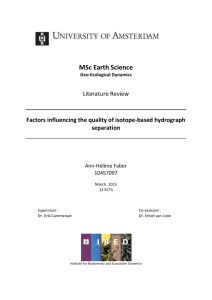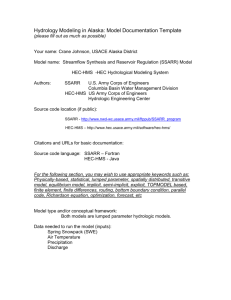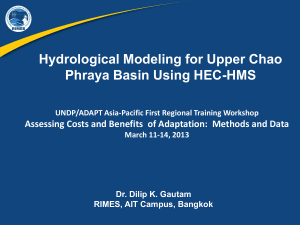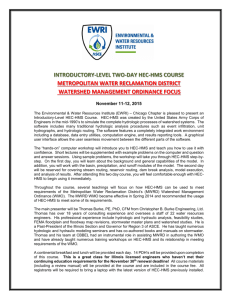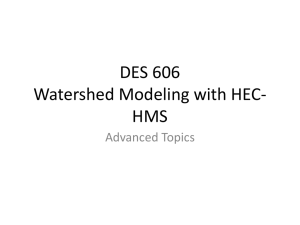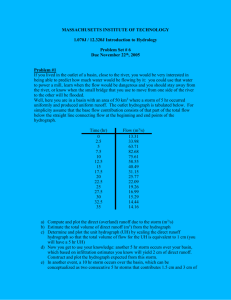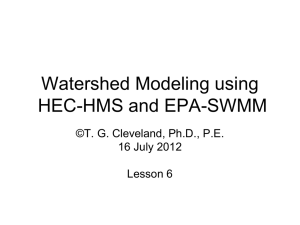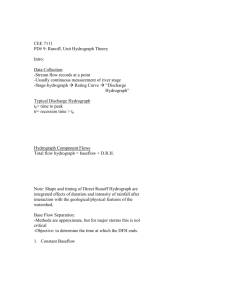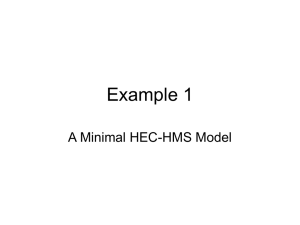Example6
advertisement
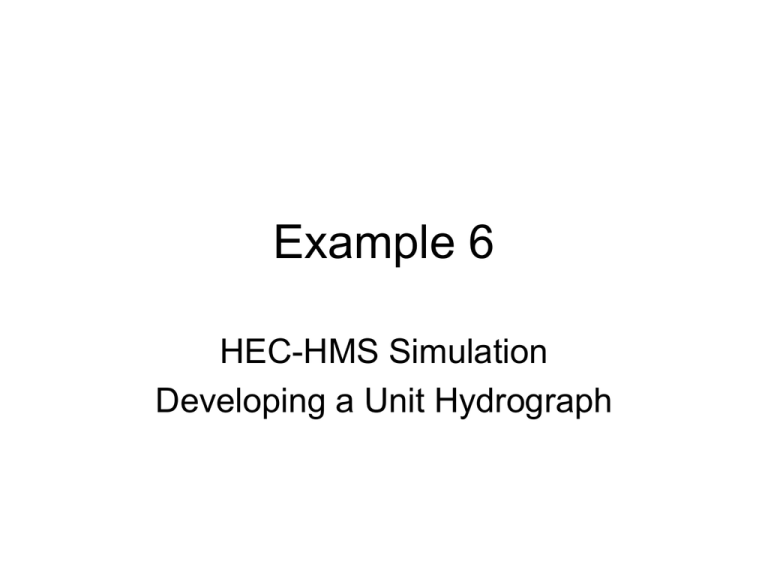
Example 6 HEC-HMS Simulation Developing a Unit Hydrograph Purpose • Illustrate using HEC-HMS to develop a unit-hydrograph – Parametric UHs – User-specified UHs Learning Objectives • Learn how to use HMS to construct a parametric Unit Hydrograph – Use trial-and-error to select parameters that fit observations. • Learn how to supply an arbitrary userspecified Unit Hydrograph to HMS Problem Statement • Determine the UH parameters for the precipitation and direct runoff for the watershed of Example 6.2 in FHWA “Highway Hydrology” – Use FHWA rainfall and direct runoff values as input and runoff. Background and Data • Watershed Properties – AREA = 0.39mi2 – SLOPE = Unknown – CN = Unknown – Precipitation = Given – Direct Runoff = Given Background and Data • Precipitation Background and Data • Direct Runoff – Baseflow already separated Approach • Actually reasonably straight-forward in HEC-HMS – Create a single sub-basin watershed. – Import the rainfall and direct runoff. – Adjust loss and UH models to fit observations. – Interpret and report results. Approach • Create a new project Approach • Create a Basin Model Approach • Create a Meterological Model Approach • Create a Hyetograph Time Series Approach • Create a Hydrograph Time Series Approach • Parameterize the Basin Model – Drainage Area = 0.39 mi2 Approach • Parameterize the Basin Model – Tlag = 30 min Approach • Create the Control Specifications – Catch the missing warnings and run Approach • First simulation – volumes mismatch, need a loss model Approach • Ia = 0.06 in, Cl =0.0 Approach • Second run, still volume mismatch. Increase the Cl value. Approach • Volumes match adequately. – Next adjust timing parameter to fit waveform Approach • Several runs adjusting lag time. – Peaks match, times good Approach • We have just “fit” the data to an NRCS DUH with Tlag = 45.3 minutes Different Loss Model • We could try a different loss model – NRCS CN model; guess CN=85 Different UH Model • Clark UH – Two parameters, Tc and R User Supplied UH Model • Empirical UH – Prepared externally – Import using PAIRED data manager User Supplied UH Model • Empirical UH – Normalized to produce 1-unit (inch) runoff. – 1 unit excess input will produce the hydrograph. User Supplied UH Model • Empirical UH – Original loss model. User Supplied UH Model • Check that indeed a unit hydrograph • How? – Add a “design storm” that has total excess of 1-unit (inch). – Verify returns 1-unit (inch) of runoff. User Supplied UH Model • Add a “design storm” that has total excess of 1-unit (inch). User Supplied UH Model • Verify returns 1-unit (inch) of runoff. Reasonably close User Supplied UH Model • Rescale the ordinates and repeat. Exact Parametric UH Model • Verify returns in same fashion. Exact Comparisons • The empirical UH and parametric UH are both unit hydrographs. • Parametric has flexibility if changing time bases considerably, and easier to communicate to other analysis – Only need send the parameter, and not a time series. HEC-HMS Example 6 • Learning Summary – Configured a single sub-basin model – Used parametric UH models to simulate responses • Adjusted parameters until fit was “good” – Used an empirical UH model based on the supplied runoff hydrograph • Normalized and time-shifted into a UH HEC-HMS Example 6 • Learning Summary – Verified both models were UH by • Apply single 1-inch depth pulse • Disable loss model to guarantee 1-inch excess input. • Observed that computed watershed runoff depth was 1-inch HEC-HMS Example 6 • Learning Summary – The empirical UH rescaling is how durations could be changed to produce a UH with a different duration. – Empirical UH are entered as PAIRED data. HEC-HMS Example 5 • Closing Remarks – Example 6 shows how to enter a userspecified hydrograph, thus the Gamma Unit Hydrograph is now a useable tool for HECHMS HEC-HMS Example 6 • Learn more – HEC HMS user manual – FHWA-NHI-02-001 Highway Hydrology • Next module – Workshop to explore the first 7 modules and work selected problems in HEC-HMS
